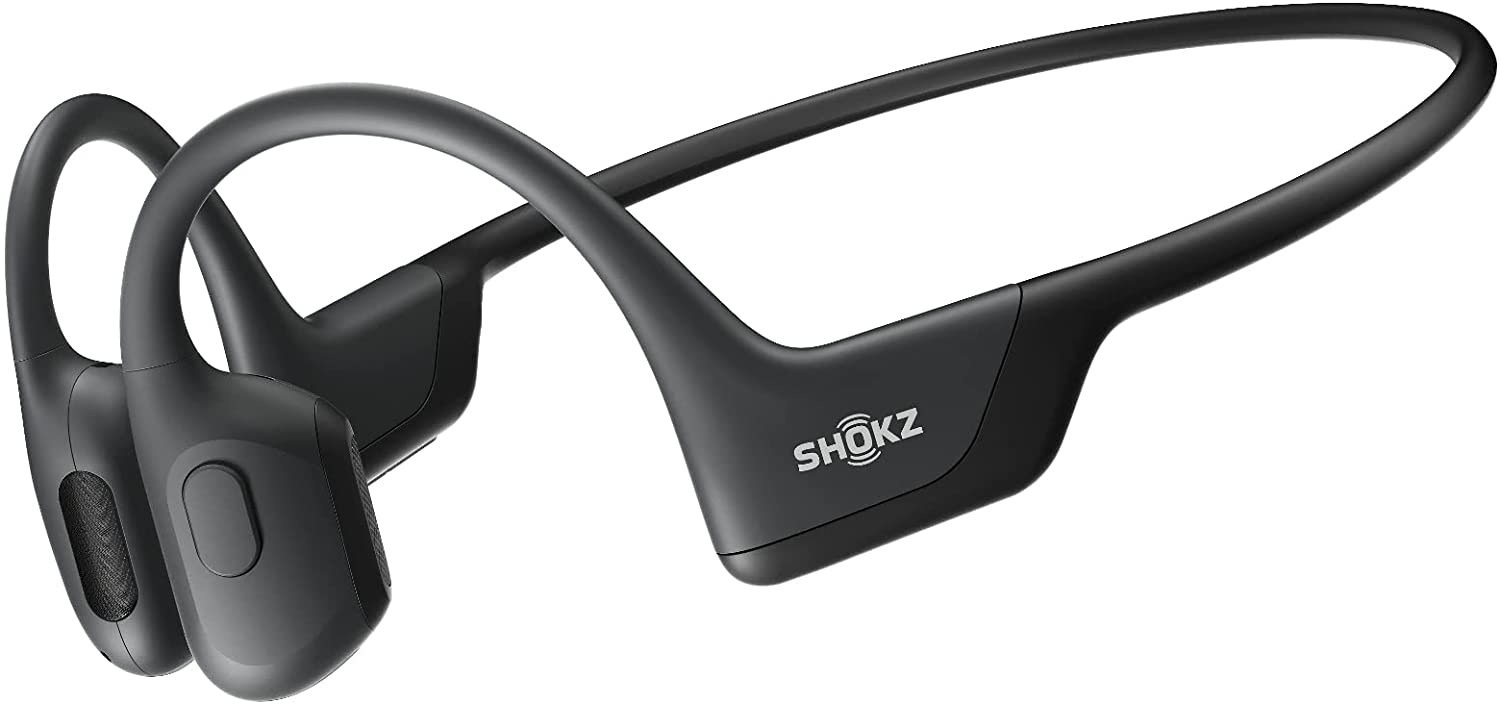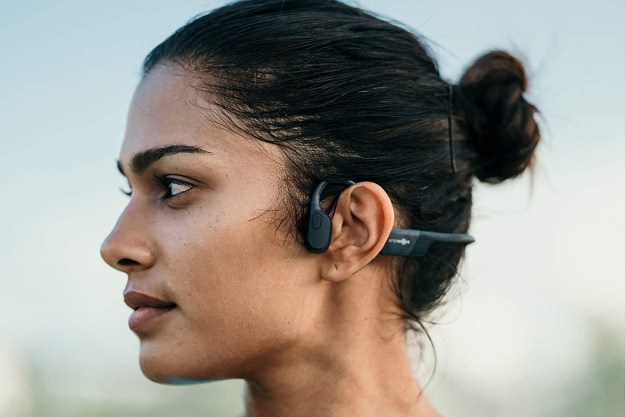





Bone conduction headphones have taken the world by storm, and we’re all about this relatively new and exciting audiio technology. If you’ve never seen one of these headsets in the wild, the idea is relatively simple: A series of sound waves are generated by a set of conductors that rest along your jawbone. These waves create vibrations throughout the skull and jaw that our inner ears register as sound.
With traditional headphones and earbuds, sound waves need to pass by our eardrums first, before arriving at the inner ear. This is why bone conduction headphones are ideal for commuters, gym-goers, and loud workplaces. The sounds of your immediate listening environment will still be audible (because your ears are technically headphone-free), but you’ll still be able to enjoy music and podcasts via the vibrations in your cranium. Similarly, open-ear earbuds and headphones are also a good choice for letting in outside sound, but they're not to be confused with bone conduction.
While most of the best bone conduction headphones are still made by Shokz (a company that gets three shoutouts in our roundup), there are several other brands that do an excellent job with this unique technology.

Shockz OpenRun Pro
Best overall
- High-quality titanium design
- Good sound quality
- Great fit
- Battery life isn't as good as many headphones
Back when Shockz was Aeropex and their headphones were called Aftershockz, they were the best bone conduction option in town. Fortunately, nothing has changed since their rebrand. In fact, their bone conduction technology is better than ever, and these premium OpenRun Pro headphones are your best bet for bone conduction technology.
The design has been updated for a more comfortable fit — something that’s always important with bone conduction headphones, which need a firm grip that doesn’t become uncomfortable over time — and improved sound quality. The titanium frame is both slim and durable, and they're able to deal with the daily grind of activities like jogging and biking. Plus, they can take a pounding at the bottom of your workout bag. The battery isn’t the best in the world at 10 hours, but the fast-charge mechanism is more than welcome if you forget to recharge before a run and want to be ready.


Haylou Purfree BC01
Best on a budget
- Affordable
- Voice assistant support
- Call noise reduction
- Battery life isn't great
Bone conduction technology can be expensive, which is why many of these extra-slim headphones aren’t so slim when it comes to pricing. If you’re looking for a model under $100 or so, we were impressed by this version from Haylou. Like the OpenRun models, they are designed to be waterproof for rain and sweat (like all of our picks for best waterproof earbuds) while still offering strong audio quality through bone conduction.
In addition to traditional on-board controls, the headphones also offer a multifunction button to take calls (enhanced with noise-canceling features for calls) or turn on Siri or Google Assistant, making this an excellent option for those who use voice assistants on the go. Battery life, however, falls short at eight hours compared to the 10 hours offered by the OpenRun Pro, and while quick charge is here, it’s not quite as good. The design uses titanium for a more flexible approach, but you may also want to be more careful to avoid damaging these headphones.


Mojawa Mojo 2
The best for exercising
- Great bass
- Secure fit
- IP67 rated
- Includes fast-charging
- So-so battery life
Whether you’re a cycling enthusiast, a bodybuilder, or a master of fencing, sports devotees the world over can make great use of the excellent Mojo 2 bone conduction headset from Mojawa. Earning a solid IP67 rating, the Mojo 2 (aka the Run Air) headset is perfect for even the sweatiest of workouts. And because they fit snug and securely, you won’t have to worry about constantly adjusting them while you’re trying to get your reps in.
We’re glad that Mojawa decided to pay a little more attention to bass too, a part of the audio experience that typically takes a big hit with bone conduction headsets. This is thanks to the integrated Maglev bass actuator, which enhances the low end frequencies that travel throughout the bones in your head and neck. These aren’t going to give you the type of thump we’d expect from premium headphones or earbuds, but it’s definitely better than most bone conduction products.
As far as battery goes, the Mojo 2 headset delivers up to eight hours of power on a full charge, but this can drop down faster if you’re rocking out at higher volumes. To combat this though, Mojawa designed the headset with quick charging in mind. Just 10 minutes of charge time will get you an extra 90 minutes of music and podcasts. Additionally, if you want to save $20, the Mojawa Mojo 1 model are very similar.


Shokz OpenSwim
Best for swimming
- Swimming design with earplugs and nose clip
- MP3 player for built-in songs
- Durable and waterproof
- No fast charge for limited battery life
Bone conduction headphones have another important forte — they are excellent for swimmers. Their unique design means it’s a bit easier to adapt them to be waterproof, and they don’t have the same danger of falling out as earbuds do. But you still get to listen to the tunes you want while in the water, no matter what you’re doing.
Shokz has fit these headphones with several important extras for swimming, too. That includes an included nose clip and earplug (which help improve audio quality, too) and, notably, a built-in MP3 player. That means you can pre-download your playlists on the headphones and play them without worrying about a Bluetooth connection, which can often get lost when doing laps in a swimming pool. Battery life is still a bit limited at eight hours, so make sure you charge up before hitting the pool. If this pair doesn't quite match your needs, we have a full roundup of the best headphones for swimming, too.


Shokz OpenComm
Best for business
- Great for business with its noise-canceling microphone
- Better battery life for longer shifts
- Great for truckers and factory workers
- Not as advanced as newer Shokz models
This OpenComm model from Shokz is made for more than just music. With its noise-canceling boom microphone, it allows for easier communication in noisy environments while also keeping your ears clear for safety and quick conversations with nearby teammates.
That makes these headphones ideal for truckers and others in the transportation industry as well as those working on a factory floor or in other industrial capacities. Office workers may also enjoy them as an alternative to chatting with a traditional headset on. The battery also offers 16 hours of talk time and eight hours of audio playback on a single charge.


H20 Audio Multi-Sport
Best for internal storage
H20 Audio may not be a brand of headphones we’re running to the stores in droves for, but if you’re looking for a solid bone conduction headset with a built-in memory bank for a favorite playlist or two, one should look no further than the H20 Audio Multi-Sport Bone Conduction Headphones.
What wins us over with this model is that H20 Audio thought to include up to 8GB of internal storage with this headset. Remember the days of MP3 players? So does H20 Audio. And if you don’t feel like uploading tracks to the Multi-Sport, that’s okay too, because the headset will still pair to your smartphone, tablet, or laptop via Bluetooth.
Admittedly, this won’t be too useful if you’re going to be using these IPX8-rated headphones for swimming, as Bluetooth doesn’t work well underwater. But if you’re going to be on land, and near your iPhone, you should have no problem enjoying wireless music.
With six hours of battery life to spare (with volume at 50 percent or less), H20 Audio won’t be taking home any trophies for long-lasting performance, but if you’re using the headset at the gym or in the pool, six listening hours should be enough for most folks.

Editors' Recommendations
- The best open-ear earbuds and headphones for 2024
- Shokz sale: Get up to 31% off bone conduction headphones
- The best wireless headphones for 2024 from Bose, Sony, 1More and more
- Best headphones for 2024: Sony, Bose, Apple, and more
- The 11 best noise-canceling headphones for 2024






